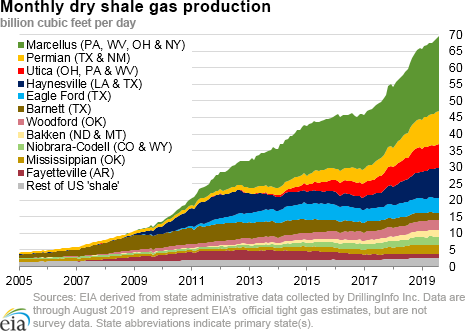In the News:
China introduces new incentives for domestic production of tight and shale gas and coalbed methane
In June 2019, the Chinese government introduced a new subsidy program that, for the first time, offers incentives for domestic production of natural gas from tight formations. The program also extended subsidies for natural gas production from shale formations and from coalbed methane (CBM). The new subsidy program aims to stimulate further growth in domestic natural gas production and to reduce China’s increasing reliance on imports, which have grown from 15% of the total supply in 2010 to 45% in 2018.
In recent years, rapid growth in China’s natural gas consumption has outpaced the growth in its domestic production, which resulted in increased natural gas imports by both pipeline and liquefied natural gas (LNG), particularly in peak winter months. Between 2010 and 2018, China’s domestic natural gas production increased by 6.1 billion cubic feet per day (Bcf/d), accounting for 37% of total supply growth, while natural gas imports grew by 10.5 Bcf/d (63% of total supply growth) during the same period.
Between 2010 and 2018, natural gas production from tight resources increased by 3.3 Bcf/d, while shale production increased by 1.0 Bcf/d and CBM production grew by 0.6 Bcf/d. In 2018, production from these resources accounted for 43% of total natural gas production in China, which included tight gas (28%), shale (7%), CBM (6%), and coal-to-natural gas (called synthetic gas) (2%).
In the new subsidy program, which covers 2019 through 2023, CBM production qualifies for higher subsidies than natural gas produced from shale and tight formations, reflecting the higher cost of CBM production. For production from tight formations, only the incremental volume based on 2017 production levels will qualify for subsidies. Natural gas produced during the heating season (November–February) receives higher subsidies, giving producers more incentives to help alleviate shortages during peak winter demand. The Chinese government also removed the requirement for foreign companies to establish partnerships with domestic Chinese companies to operate in the oil and natural gas upstream sector.
China has been developing tight gas from low-permeability formations since the 1970s. Tight gas production was negligible until 2010, when companies initiated an active drilling program that helped lower the drilling cost per vertical well and improve well productivity. Growth in production from shale and CBM resources has been affected by complex geology, deep reservoirs, low well productivity, and some of the highest per unit production costs of the Chinese natural gas resource base.
In September 2018, the Chinese State Council set a target of 19.4 Bcf/d for domestic natural gas production in 2020. To meet this target, China needs to increase total natural gas production by 4.4 Bcf/d compared with the 2018 level.
Overview:
(For the week ending Wednesday, September 18, 2019)
- Natural gas spot prices fell at most locations this report week (Wednesday, September 11 to Wednesday, September 18). Henry Hub spot prices rose from $2.59 per million British thermal units (MMBtu) last Wednesday to $2.68/MMBtu yesterday.
- At the New York Mercantile Exchange (Nymex), the price of the October 2019 contract increased 9¢, from $2.552/MMBtu last Wednesday to $2.637/MMBtu yesterday. The price of the 12-month strip averaging October 2019 through September 2020 futures contracts increased by 3¢/MMBtu to $2.587/MMBtu.
- Net injections to working gas totaled 84 billion cubic feet (Bcf) for the week ending September 13. Working natural gas stocks are 3,103 Bcf, which is 15% more than the year-ago level and 2% lower than the five-year (2014–18) average for this week.
- The natural gas plant liquids composite price at Mont Belvieu, Texas, rose by 13¢/MMBtu, averaging $4.99/MMBtu for the week ending September 18. The price of ethane fell by 1%. The price of natural gasoline, propane, butane, and isobutane rose by 4%, 3%, 3%, and 6%, respectively.
- According to Baker Hughes, for the week ending Tuesday, September 10, the natural gas rig count decreased by 7 to 153. The number of oil-directed rigs fell by 5 to 733. The total rig count decreased by 12, and it now stands at 886.
Prices/Supply/Demand:
Prices fall across the country. This report week (Wednesday, September 11 to Wednesday, September 18), Henry Hub spot prices rose 9¢ from $2.59/MMBtu last Wednesday to $2.68/MMBtu yesterday after reaching a high of $2.75/MMBtu on Monday. Seasonal temperatures were moderate, averaging in the 70s (degrees Fahrenheit) across most of the country. At the Chicago Citygate, prices increased 2¢ from $2.37/MMBtu last Wednesday to $2.39/MMBtu yesterday.
California prices are down. Prices at PG&E Citygate in Northern California fell 12¢, down from $3.23/MMBtu last Wednesday to a low of $3.11/MMBtu yesterday. Prices at SoCal Citygate decreased 14¢ from $3.32/MMBtu last Wednesday to $3.18/MMBtu yesterday.
Northeast prices fall. At the Algonquin Citygate, which serves Boston-area consumers, prices decreased by 24¢ from a high of $2.38/MMBtu last Wednesday to $2.14/MMBtu yesterday with temperatures slightly cooler than normal. At the Transcontinental Pipeline Zone 6 trading point for New York City, prices decreased 29¢ from $2.30/MMBtu last Wednesday to a low of $2.01/MMBtu yesterday.
Tennessee Zone 4 Marcellus spot prices decreased 12¢ from $1.99/MMBtu last Wednesday to $1.87/MMBtu yesterday. Prices at Dominion South in southwest Pennsylvania fell 2¢ from $2.00/MMBtu last Wednesday to $1.98/MMBtu yesterday.
Permian Basin prices strengthen throughout the week as the Sur de Texas-Tuxpan pipeline enters service and flows on the Gulf Coast Express ramp up. Prices at the Waha Hub in West Texas, which is located near the Permian Basin production area, averaged $1.68/MMBtu last Wednesday, 91¢/MMBtu lower than Henry Hub prices. Yesterday, prices at the Waha Hub averaged $1.89/MMBtu, 79¢/MMBtu lower than Henry Hub prices. During the week, flows on the Gulf Coast Express have ramped up and averaged more than 1 Bcf/d as the pipeline prepares to enter full service by the end of this month, according to SP Global Platts. On Tuesday, IEnova and TC Energía announced the Sur de Texas-Tuxpan marine natural gas pipeline began commercial operations. The 2.6 Bcf/d pipeline will flow from Brownsville, Texas, to the Mexican coastal cities of Altamira in Tamaulipas and Tuxpan in Veracruz. The pipeline will supply power plants in Altamira and feed into Mexico’s national Sistrangas pipeline system. Flows in its first week ranged from 0.0 Bcf/d to 0.6 Bcf/d according to Genscape.
Supply is flat. According to data from IHS Markit, the average total supply of natural gas remained the same as in the previous report week, averaging 96.2 Bcf/d. Dry natural gas production remained constant week over week. Average net imports from Canada increased by 1% from last week.
Demand falls. Total U.S. consumption of natural gas fell by 4% compared with the previous report week with cooler temperatures across most of the country, according to data from IHS Markit. Natural gas consumed for power generation declined by 5% week over week. Industrial sector consumption decreased by 1% week over week. In the residential and commercial sectors, consumption declined by 1%. Natural gas exports to Mexico decreased 1%.
U.S. LNG exports increase week over week. Twelve LNG vessels (seven from Sabine Pass, two from Cove Point, two from Corpus Christi, and one from Freeport LNG export terminals) with a combined LNG-carrying capacity of 42 Bcf departed the United States between September 12 and September 18, according to shipping data compiled by Bloomberg. Four vessels (two at Sabine Pass, one at Corpus Christi and one at Cove Point terminals) were loading on Wednesday.
Storage:
Net injections into storage totaled 84 Bcf for the week ending September 13, compared with the five-year (2014–18) average net injections of 82 Bcf and last year's net injections of 84 Bcf during the same week. Working gas stocks totaled 3,103 Bcf, which is 75 Bcf lower than the five-year average and 393 Bcf more than last year at this time.
According to The Desk survey of natural gas analysts, estimates of the weekly net change from working natural gas stocks ranged from net injections of 73 Bcf to 82 Bcf, with a median estimate of 78 Bcf.
The average rate of net injections into storage is 28% higher than the five-year average so far in the refill season (April through October). If the rate of injections into storage matched the five-year average of 10.7 Bcf/d for the remainder of the refill season, total inventories would be 3,617 Bcf on October 31, which is 75 Bcf lower than the five-year average of 3,692 Bcf for that time of year.
More storage data and analysis can be found on the Natural Gas Storage Dashboard and the Weekly Natural Gas Storage Report.
See also:
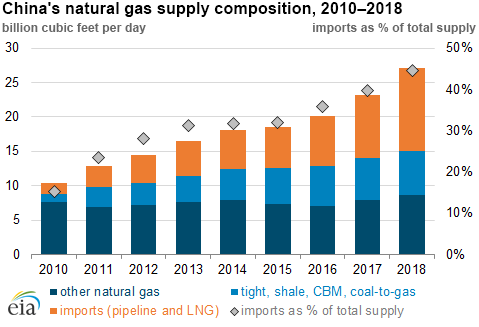 Sources: U.S. Energy Information Administration, based on China National Bureau of Statistics and IHS Markit
Sources: U.S. Energy Information Administration, based on China National Bureau of Statistics and IHS Markit Note: CBM stands for coalbed methane
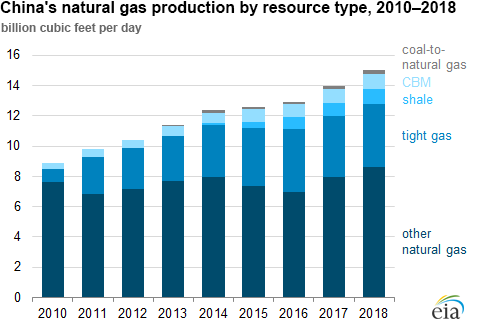 Sources: U.S. Energy Information Administration, based on China National Bureau of Statistics and IHS Markit
Sources: U.S. Energy Information Administration, based on China National Bureau of Statistics and IHS Markit Note: CBM stands for coalbed methane
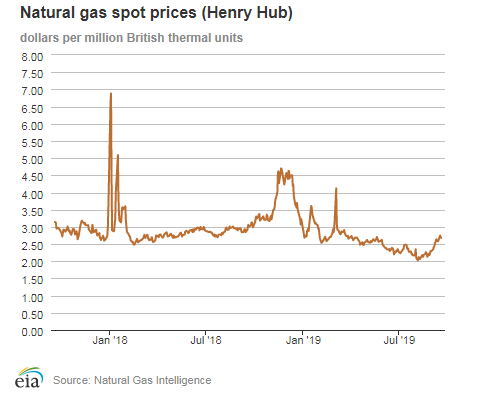
| Spot Prices ($/MMBtu) | Thu, 12-Sep |
Fri, 13-Sep |
Mon, 16-Sep |
Tue, 17-Sep |
Wed, 18-Sep |
|---|---|---|---|---|---|
| Henry Hub |
2.58 |
2.61 |
2.75 |
2.70 |
2.68 |
| New York |
2.10 |
2.11 |
2.26 |
2.18 |
2.01 |
| Chicago |
2.31 |
2.26 |
2.41 |
2.39 |
2.39 |
| Cal. Comp. Avg.* |
3.00 |
2.66 |
2.66 |
2.67 |
2.69 |
| Futures ($/MMBtu) | |||||
| October contract | 2.574 |
2.614 |
2.681 |
2.668 |
2.637 |
| November contract |
2.605 |
2.653 |
2.725 |
2.700 |
2.665 |
| *Avg. of NGI's reported prices for: Malin, PG&E Citygate, and Southern California Border Avg. | |||||
| Sources: Natural Gas Intelligence and CME Group as compiled by Bloomberg, L.P. | |||||
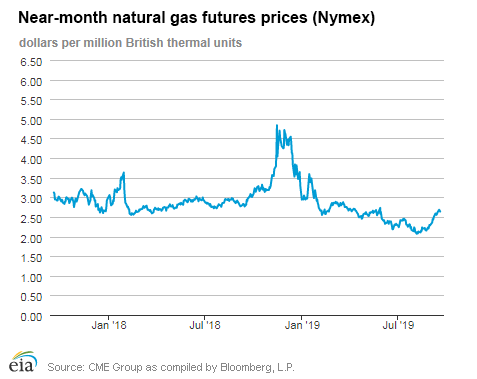
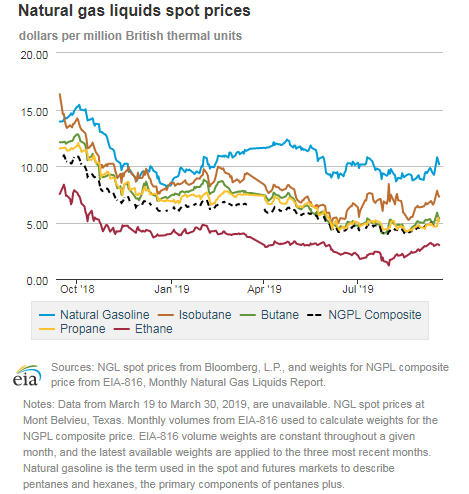
| U.S. natural gas supply - Gas Week: (9/12/19 - 9/18/19) | |||
|---|---|---|---|
Average daily values (Bcf/d): |
|||
this week |
last week |
last year |
|
| Marketed production | 103.0 |
103.6 |
96.0 |
| Dry production | 91.6 |
92.0 |
86.0 |
| Net Canada imports | 4.6 |
4.5 |
4.6 |
| LNG pipeline deliveries | 0.1 |
0.1 |
0.1 |
| Total supply | 96.2 |
96.5 |
90.7 |
|
Source: IHS Markit | |||
| U.S. natural gas consumption - Gas Week: (9/12/19 - 9/18/19) | |||
|---|---|---|---|
Average daily values (Bcf/d): |
|||
this week |
last week |
last year |
|
| U.S. consumption | 65.3 |
67.8 |
65.3 |
| Power | 35.4 |
37.4 |
35.4 |
| Industrial | 21.2 |
21.5 |
20.9 |
| Residential/commercial | 8.7 |
8.9 |
9.0 |
| Mexico exports | 5.0 |
5.1 |
5.0 |
| Pipeline fuel use/losses | 6.3 |
6.4 |
6.0 |
| LNG pipeline receipts | 6.5 |
5.8 |
3.2 |
| Total demand | 83.2 |
85.0 |
79.5 |
|
Source: IHS Markit | |||
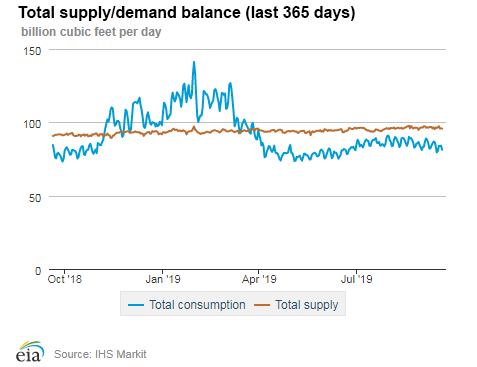
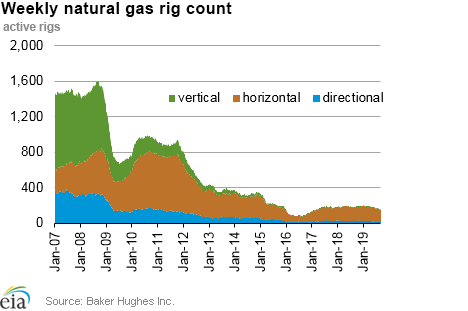
| Rigs | |||
|---|---|---|---|
Tue, September 10, 2019 |
Change from |
||
last week |
last year |
||
| Oil rigs | 733 |
-0.7% |
-15.5% |
| Natural gas rigs | 153 |
-4.4% |
-17.7% |
| Note: Excludes any miscellaneous rigs | |||
| Rig numbers by type | |||
|---|---|---|---|
Tue, September 10, 2019 |
Change from |
||
last week |
last year |
||
| Vertical | 53 |
10.4% |
-15.9% |
| Horizontal | 776 |
-0.9% |
-15.7% |
| Directional | 57 |
-14.9% |
-19.7% |
| Source: Baker Hughes Inc. | |||
| Working gas in underground storage | ||||
|---|---|---|---|---|
Stocks billion cubic feet (Bcf) |
||||
| Region | 2019-09-13 |
2019-09-06 |
change |
|
| East | 763 |
739 |
24 |
|
| Midwest | 898 |
864 |
34 |
|
| Mountain | 188 |
183 |
5 |
|
| Pacific | 279 |
275 |
4 |
|
| South Central | 974 |
958 |
16 |
|
| Total | 3,103 |
3,019 |
84 |
|
|
Source: Form EIA-912, Weekly Underground Natural Gas Storage Report | ||||
| Working gas in underground storage | |||||
|---|---|---|---|---|---|
Historical comparisons |
|||||
Year ago (9/13/18) |
5-year average (2014-2018) |
||||
| Region | Stocks (Bcf) |
% change |
Stocks (Bcf) |
% change |
|
| East | 705 |
8.2 |
780 |
-2.2 |
|
| Midwest | 765 |
17.4 |
881 |
1.9 |
|
| Mountain | 169 |
11.2 |
195 |
-3.6 |
|
| Pacific | 254 |
9.8 |
306 |
-8.8 |
|
| South Central | 816 |
19.4 |
1,017 |
-4.2 |
|
| Total | 2,710 |
14.5 |
3,178 |
-2.4 |
|
| Source: Form EIA-912, Weekly Underground Natural Gas Storage Report | |||||
| Temperature – heating & cooling degree days (week ending Sep 12) | ||||||||
|---|---|---|---|---|---|---|---|---|
HDD deviation from: |
CDD deviation from: |
|||||||
| Region | HDD Current |
normal |
last year |
CDD Current |
normal |
last year |
||
| New England | 21 |
3 |
1 |
7 |
-1 |
-14 |
||
| Middle Atlantic | 7 |
-5 |
-11 |
22 |
3 |
-5 |
||
| E N Central | 13 |
-4 |
-8 |
33 |
14 |
20 |
||
| W N Central | 14 |
-9 |
-3 |
50 |
23 |
27 |
||
| South Atlantic | 0 |
-2 |
-1 |
99 |
30 |
8 |
||
| E S Central | 0 |
-2 |
-1 |
94 |
35 |
15 |
||
| W S Central | 0 |
-2 |
-1 |
129 |
36 |
45 |
||
| Mountain | 13 |
-14 |
7 |
58 |
12 |
-7 |
||
| Pacific | 3 |
-6 |
-1 |
32 |
-2 |
-17 |
||
| United States | 7 |
-5 |
-4 |
60 |
17 |
8 |
||
|
Note: HDD = heating degree day; CDD = cooling degree day Source: National Oceanic and Atmospheric Administration | ||||||||
Average temperature (°F)
7-day mean ending Sep 12, 2019
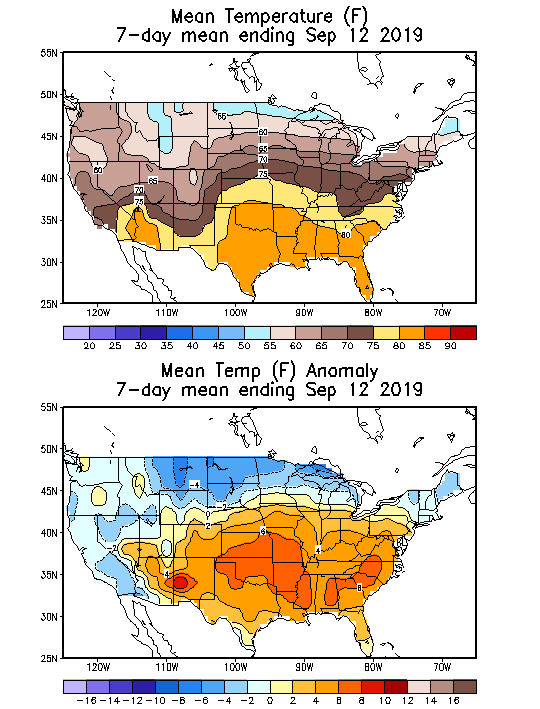
Source: National Oceanic and Atmospheric Administration
Deviation between average and normal (°F)
7-day mean ending Sep 12, 2019

Source: National Oceanic and Atmospheric Administration

